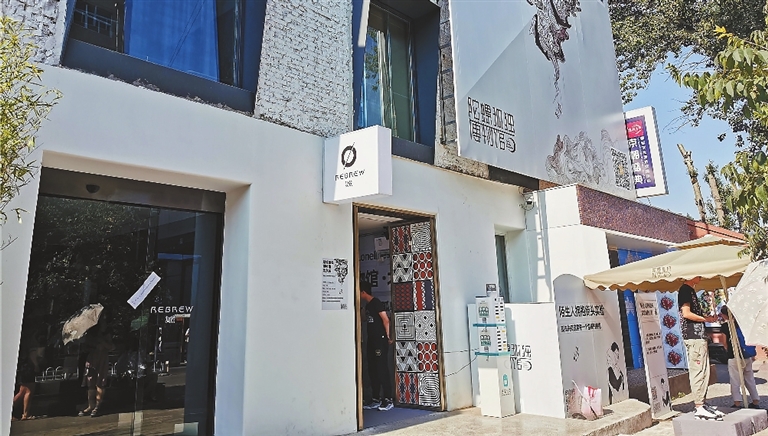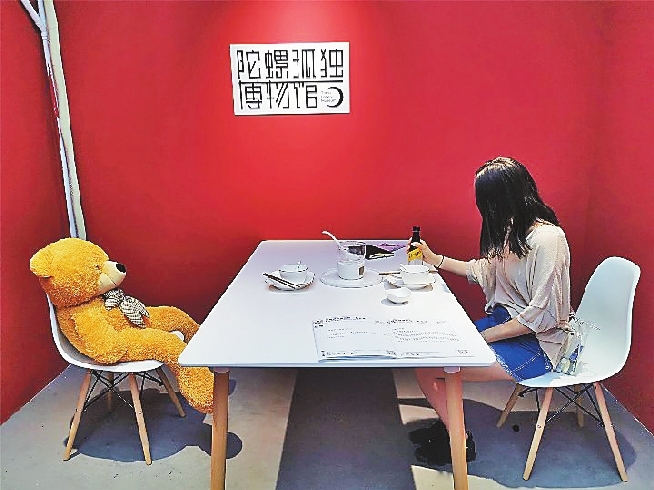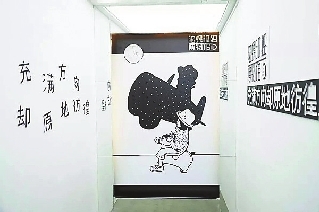



LOCATED in one of Beijing’s most active art communities, the Torro Loneliness Museum is always packed and bustling, but everyone here claims they are lonely.
Liu Jiawei, a 22-year-old university student, sat quietly opposite a fluffy toy bear and ate hot pot, went to the hospital alone and took the last subway home. Learning to deal with solitude after ending a long relationship was a challenge for her.
“When you are used to being together with someone, you will feel uncomfortable when suddenly separated,” Liu said.
The Torro Loneliness Museum, which opened two weeks ago in the 798 Art Zone, aims to reproduce several scenes of loneliness, with which visitors can be immersed and resonate. Divided into 13 sections including an office at night, the last subway train, a hotpot restaurant and a hospital, the museum displays over 1,000 lonely stories from different people, with words of encouragement and ways to deal with solitude written on the walls and the stairs.
Despite its theme, it is not always a solitary journey through the museum. In a room with three stationary bicycles, strangers can ride simultaneously to light up the bulbs on the wall, which form a sentence — “loneliness comes together with love.”
Liu pedaled the bicycle at full tilt alongside two other girls. When the bulbs on the walls finally lit up, they laughed together even though they had never met before.
“I have always been sad these days, but I felt very relaxed and happy just now,” Liu said.
Han Yue, one of the co-founders of Torro, the operating company of the museum, said that everyone feels lonely sometimes for different reasons.
In early 2018, Han’s grandfather passed away from cancer while he was leading a tour group in Nepal.
“When I came back to the empty home, I took out my items one by one from the suitcase with tears dropping on them, but I couldn’t face the reality that my grandpa was no longer there,” Han said, recalling the loneliest time he had ever experienced.
It dawned on him that a single event or trip might not be enough for people to relieve their sadness or loneliness. Their team, all of whom are under 30, had previously organized hundreds of offline activities, including a color run, a music festival and desert trips, for urban youth to gather together and shed their loneliness.
Han and the four other team members aim to create a haven where lonely people can stay and others can empathize with their feelings.
With over 300,000 followers on social media, Torro published an article to collect stories about loneliness, and over 1,000 different experiences flooded in from all over the country. Those stories and feelings from their readers became a source of inspiration for the museum and were printed out and scattered throughout the exhibits.
Liu Shiyu, a 23-year-old graduate student in Beijing, brought her camera to the museum to try out her new hobby.
In her eyes, this generation of young people is different from their parents. They worry less about livelihood but face more interpersonal and social pressure.
“When I’m in a bad mood, I avoid reaching out to my friends because emotions are contagious and everyone is under a lot of pressure. I don’t even tell my parents because they may not understand,” she said.
Diaries, sports and museums like this have become ideal ways to improve one’s mood.
“The museum provides feelings of empathy. When you read the stories, you feel like you can connect with someone experiencing similar emotions,” Liu Shiyu said.
According to a report titled “National Mental Health Development in China (2017-2018)” published by the Institute of Psychology of the China Academy of Sciences in February, the national mental health index declines with age during the adolescent stage (12-18 years old) and gradually rises in adulthood (18-55 years old), indicating that people often experience a downturn in their mental health during their youth.
Han said his team is currently negotiating with other cities to open loneliness museums in more places.
On Meituan, a Chinese Yelp-like online city-guide, the Torro Loneliness Museum had scored 4.8 out of 5 after 86 reviews. Although many people complimented the design and concept of the museum, some questioned whether it was just a commercial gimmick with fancy decorations and prosaic stories.
Guan Yutong, a Beijing-based psychological counselor, admitted that when lonely people find similar lonely hearts in the museum, they may gain a sense of belonging and overcome their solitude. However, she also worried that such an exhibition might create a lonely atmosphere and spread it to those who initially did not feel depressed.
Fang Fang, one of the curators of the museum, did not share such concerns. “People who come to work in big cities like Beijing can sometimes suddenly feel lonely and vulnerable. We want to create a place where lonely people can relax, and be recognized and accepted.”
“The museum is not a pretentious gesture that will exaggerate people’s pain. It reminds them that even though life is hard, there are thousands of people in this city just like them,” Fang added.
(Xinhua) | 
